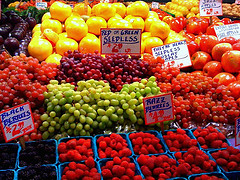Don't Get Yourself Sick: Common Unhealthy Food Prep & Kitchen Mistakes To Avoid

(Ninja M.)
Food poisoning is never fun, and it’s even worse when the comestible in question could’ve come from your own kitchen and can’t be blamed on the neverending buffet at the strip mall. When it comes to home food preparation, it’s always better to be safe than sorry. We’re lucky enough to have a few tips to pass on from our smart siblings over at ShopSmart magazine on how to keep your kitchen devoid of anything that will lead to feeling like you’ll never, ever eat food again.
First step: Cleaning your food properly is key. A quick rinse won’t do it! There are some simple gadgets you’ll need to help, but just as important is keeping them clean so as to avoid contamination. All tools should be run through the dishwasher or washed with hot, soapy water and dried with a clean cloth. Make sure you have a colander or strainer for rinsing veggies, a corer or clean paring knife, a vegetable brush, salad spinner, separate cutting boards for produce and raw meat (replace them when they get deep scratches), spray bottles for cleaning tools instead of using bacteria-spreading sponges and containers to keep produce from becoming contaminated in the fridge.
Second step: Get the cooties off. Leafy greens, tomatoes, sprouts, and berries are some of the top culprits behind produce-caused outbreaks of food-borne illness. Cantaloupe has also triggered its share of scares. But all fruits and veggies still need proper washing to get dirt and pesticide residues off. The following tips will show you how.
Leafy greens: For lettuce, chard, cabbage, spinach, and other leafy greens, toss the outside leaves, where dirt and bacteria are likely to lurk. Separate the remaining leaves and wash individually, rubbing gently to dislodge soil and bacteria. After washing, blot dry with paper towels or use a salad spinner to remove excess moisture.
Tender produce: Wash plums, peaches, tomatoes, and other soft produce under cool, briskly running water for 30 to 60 seconds. Rubbing gently with your hands or a nylon scrubber can help remove soil, surface bacteria, and pesticides. Cut away any damaged or decayed areas. Dry thoroughly with clean paper towels.
Rough-textured produce: Scrubbing is essential for dimply cantaloupes—which have been linked to recent disease outbreaks—and gnarly root vegetables. Their uneven textures make it easier for bacteria to attach tightly in little crevices. To minimize the risk of contaminating your food, scrub with a vegetable brush under briskly running water—even if you’re going to peel it. Dry thoroughly.
Peelable produce: Even smooth-skinned fruits that you plan to peel should be washed, especially mangoes and papayas, which have been associated with disease outbreaks. But dirt can be transferred to any fruit once cut, so rub all produce gently with your hands under running water for 30 to 60 seconds, then dry thoroughly. Apples, cucumbers, watermelon, and other firm, peelable produce can be washed under running water with a veggie brush before peeling or eating. But be sure to use the fruit right away. Peeling and cutting releases nutrients and juices that encourage bugs to grow.
Small fruits: Place fragile berries in a clean colander and use your sink sprayer to rinse thoroughly while tumbling them around. the same method works for hardier small fruits, but you can also rub them with your fingers to help dislodge any nasty hangers-on. Follow with a pat-down with paper towels. If you’re using strawberries, be sure to clean under the green cap.
Third step: Clean your fridge! After all that cleaning you just did, why would you store your stuff in a dirty den of bacteria? Clean it out weekly and toss spoiled food, while spot-cleaning any leaks you see along the way. Sanitize sponges you use to clean it in the dishwasher, and keep track of how long your perishable foods have been stored.
Want more consumer news? Visit our parent organization, Consumer Reports, for the latest on scams, recalls, and other consumer issues.

